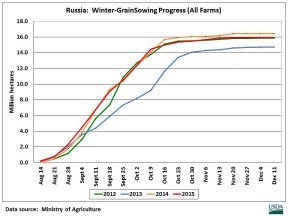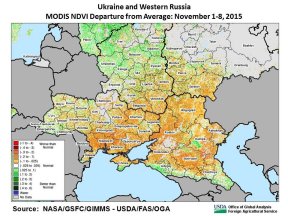Russia: Sown Area for 2016/17 Winter Grains Falls Short of Ministry Forecast
Dry weather in western Russia contributed to a 5-percent drop in the area sown to 2016/17 winter grains. The dryness curtailed planting and hampered crop establishment in some areas and conditions were generally worse than normal as the winter crops entered dormancy. The impact of the dryness on crop emergence and establishment will not be fully determined until vegetative growth resumes in the spring.
 According to data from Russia's Ministry of Agriculture, 2016/17 winter grains were sown on 15.94 million hectares (not including 0.38 million hectares in Crimea), down 0.50 million hectares from last year and 0.77 million hectares below the Ministry forecast. The sowing campaign advanced at a rapid pace, but planted area surpassed the Ministry forecast only in the North Caucasus District, where area increased by only 2 percent. Due in part to unfavorably dry weather during the fall planting campaign, planting fell short of the forecast by 6.4 percent in the Southern District, 8.4 percent in the Volga District, and 3.5 percent in the Central District. According to data from Russia's Ministry of Agriculture, 2016/17 winter grains were sown on 15.94 million hectares (not including 0.38 million hectares in Crimea), down 0.50 million hectares from last year and 0.77 million hectares below the Ministry forecast. The sowing campaign advanced at a rapid pace, but planted area surpassed the Ministry forecast only in the North Caucasus District, where area increased by only 2 percent. Due in part to unfavorably dry weather during the fall planting campaign, planting fell short of the forecast by 6.4 percent in the Southern District, 8.4 percent in the Volga District, and 3.5 percent in the Central District.
Winter wheat typically accounts for about 85 percent of total winter-grain area in Russia and is grown in nearly all of the grain-producing region in European Russia. (The term European Russia typically denotes the section of Russia west of the Ural Mountains.) About two-thirds of the wheat produced in Russia is winter wheat. Winter rye is more cold-tolerant than wheat and is grown in more northern regions. Rye accounts for about 12 percent of the total winter-grain area. Virtually all of the rye planted in Russia is winter rye. Winter barley is the winter grain least resistant to frost and is grown only in the southernmost territories. Winter barley accounts for about 3 percent of Russia’s total winter-grain area, and for about 10 percent of Russia’s total barley output.
For the second consecutive year, dryness prevailed from the beginning of August through the end of October and hampered planting and emergence in every district in European Russia. Surface wetness, as indicated by microwave satellite imagery, was significantly lower than normal in the Central District during most of October, when planting was finished and the newly-sown crops needed moisture for emergence and establishment. With the exception of Volgograd and Rostov, the two northern-most territories in the Southern District, winter grains in the Southern and North Caucasus Districts dodged the stress that affected crops in the Central and Volga Districts. Not only was the dryness less intense, but sowing occurred several weeks later than in the more northern regions which enabled the crops to become  established under less stressful moisture conditions. established under less stressful moisture conditions.
Satellite-derived vegetation indices (Normalized Difference Vegetation Index, or NDVI) reflect the impact of this year’s dryness on winter-crop establishment. In the six southernmost territories of the Central District (Belgorod, Voronezh, Kursk, Orel, Lipetsk, and Tambov, which together account for about 80 percent of the district’s wheat output), crop conditions were below average as the crop entered dormancy. The early-November NDVI also indicate poor conditions in Krasnodar and Stavropol in southern Russia, but crop establishment benefited from increased surface moisture during November and conditions improved throughout the month.
This year’s situation for Russia’s winter crops closely resembles last year: inadequate surface moisture resulted in unfavorable establishment conditions, with late-November improvement in Krasnodar and Stavropol. Moreover, it’s worth noting that favorable spring weather in 2015 propelled 2015/16 winter-wheat output to record levels in Rostov, Krasnodar, and Stavropol territories, the country’s top three wheat-producing oblasts, and final wheat yield was above average in the Central District despite the poor establishment conditions. Similarly, final winter-grain yields for 2016/17 will be determined chiefly by spring and early-summer weather.
A brief episode of cold weather during the first week of January featured minimum temperatures as low as minus 20 degrees Celsius as far south as Krasnodar, but snow cover provided adequate protection for winter crops and the likelihood of frost damage was minimal.
Winter grains typically resume vegetative growth in March in the southern territories and in April farther north. The harvest of winter grains begins in late June in the south and is usually finished by mid-August in the Volga District.
Initial USDA estimates for 2016/17 will be published on May 10, 2016. Current USDA area and production estimates for grains and other agricultural commodities are available on IPAD's Agricultural Production page or at PSD Online.
Visit Crop Explorer http://www.pecad.fas.usda.gov/cropexplorer/
|

